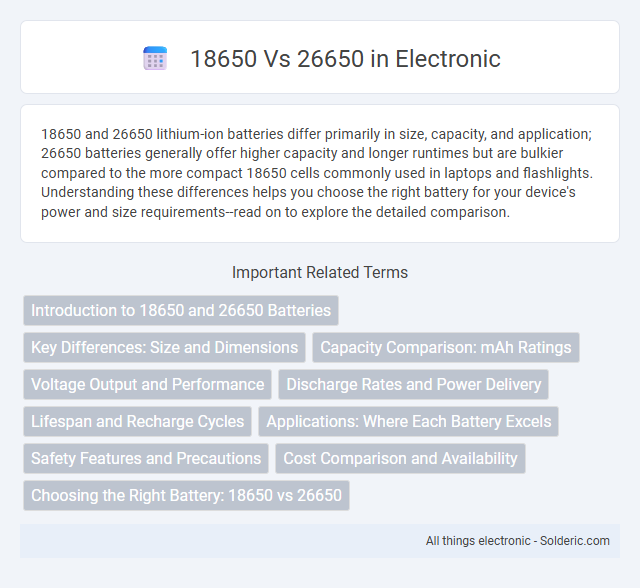18650 and 26650 lithium-ion batteries differ primarily in size, capacity, and application; 26650 batteries generally offer higher capacity and longer runtimes but are bulkier compared to the more compact 18650 cells commonly used in laptops and flashlights. Understanding these differences helps you choose the right battery for your device's power and size requirements--read on to explore the detailed comparison.
Comparison Table
| Feature | 18650 Battery | 26650 Battery |
|---|---|---|
| Dimensions | 18mm diameter x 65mm length | 26mm diameter x 65mm length |
| Capacity | Typically 1800-3500mAh | Typically 3000-6000mAh |
| Voltage | 3.6V - 3.7V nominal | 3.6V - 3.7V nominal |
| Weight | 40-50 grams | 70-90 grams |
| Discharge Rate | 10A - 30A continuous (varies by model) | 10A - 35A continuous (higher current models available) |
| Applications | Laptops, flashlights, electric vehicles, power tools | High-drain devices, electric bikes, large flashlights, power tools |
| Price | Generally lower per unit | Higher due to larger size and capacity |
Introduction to 18650 and 26650 Batteries
18650 and 26650 batteries are cylindrical lithium-ion cells widely used in high-drain devices, with the 18650 measuring 18mm in diameter and 65mm in length, while the 26650 is larger at 26mm in diameter and 65mm in length. The 18650 battery is renowned for its balance between capacity and size, making it popular in laptops, flashlights, and electric vehicles. The 26650 battery offers higher capacity and current output, preferred in applications requiring extended runtime and greater power delivery such as high-performance flashlights and power tools.
Key Differences: Size and Dimensions
The primary distinction between 18650 and 26650 batteries lies in their size and dimensions, with 18650 cells measuring 18mm in diameter and 65mm in length, while 26650 cells are larger at 26mm in diameter and 65mm in length. This size difference directly impacts energy capacity, as 26650 batteries typically offer higher mAh ratings due to their increased volume. The larger dimensions of 26650 batteries make them suitable for devices requiring longer runtimes or higher power output compared to the more compact 18650 cells.
Capacity Comparison: mAh Ratings
The 26650 battery typically offers a higher capacity ranging from 4000mAh to 6000mAh, compared to the 18650's common capacity range of 1800mAh to 3500mAh. This capacity difference translates to longer runtimes and increased energy storage for devices using the larger 26650 cells. Choosing between 18650 and 26650 cells depends largely on the required battery life and device compatibility, with 26650 being favored for high-drain applications.
Voltage Output and Performance
The 18650 and 26650 lithium-ion batteries typically have a nominal voltage of 3.6 to 3.7 volts, but the 26650 often supports higher continuous discharge currents, enhancing performance in high-drain devices. The larger capacity of 26650 cells, ranging from 3000mAh to 5000mAh, provides longer runtime compared to the 18650's 1800mAh to 3500mAh range, making the 26650 ideal for applications requiring sustained power. Voltage stability under load is generally better in 26650 batteries due to their increased size and chemical capacity, impacting overall device efficiency.
Discharge Rates and Power Delivery
The 18650 and 26650 lithium-ion batteries differ significantly in discharge rates and power delivery, with the 18650 typically offering higher continuous discharge rates up to 20-30A, suitable for devices requiring sustained high power. In contrast, the 26650, while having a larger capacity, usually has lower discharge rates around 10-20A but delivers more overall energy, making it ideal for longer run times. Your choice depends on whether you prioritize peak performance (18650) or extended usage duration (26650) for your application.
Lifespan and Recharge Cycles
The 26650 battery typically offers a longer lifespan and more recharge cycles compared to the 18650, due to its larger size and capacity, which reduces stress during discharge and charging. While 18650 cells usually provide around 300 to 500 recharge cycles, high-quality 26650 batteries can deliver 500 to 1000 cycles, enhancing their durability in high-drain applications. These characteristics make 26650 cells preferable for devices requiring extended use and reliable long-term performance.
Applications: Where Each Battery Excels
18650 batteries excel in compact devices like laptops, flashlights, and vape mods due to their high energy density and reliable performance in a smaller size. 26650 batteries are preferred for high-drain applications such as powerful flashlights, electric vehicles, and portable power tools because of their larger capacity and ability to deliver higher currents. Your choice depends on whether you need a balance of size and energy (18650) or maximum power and longer runtime (26650).
Safety Features and Precautions
The 18650 and 26650 lithium-ion batteries differ significantly in safety features; 18650 cells often include built-in protection circuits to prevent overcharging, short circuits, and overheating, while many 26650 batteries lack integrated protections, requiring external safeguards. Proper handling of both battery types involves using compatible chargers, avoiding physical damage, and storing them in a cool, dry environment to minimize risks of thermal runaway or leakage. Users must follow manufacturer guidelines strictly, especially with high-capacity 26650 cells, to ensure maximum safety and prevent potential hazards.
Cost Comparison and Availability
The 18650 batteries typically offer a more affordable price point and greater availability due to widespread use in laptops, flashlights, and electric vehicles, making them a cost-effective choice for your power needs. In contrast, 26650 batteries, often featuring higher capacity and discharge rates, tend to be more expensive and less commonly stocked by retailers, which can limit ease of purchase. When weighing cost against availability, 18650 cells are generally more accessible and budget-friendly for most applications.
Choosing the Right Battery: 18650 vs 26650
When choosing between 18650 and 26650 batteries, consider your device's power requirements and size constraints. The 26650 offers higher capacity and current output, making it ideal for high-drain devices and extended usage, while the 18650 is more compact and commonly used in smaller electronics. Your choice should balance energy needs with physical compatibility to ensure optimal performance and safety.
18650 vs 26650 Infographic

 solderic.com
solderic.com